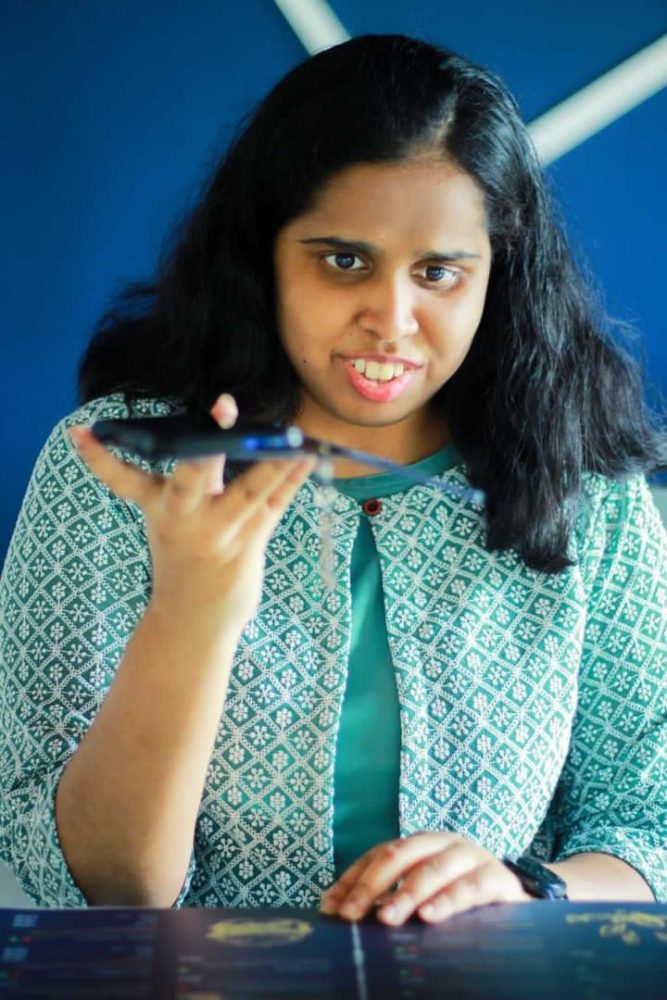This article, a winner in the competition held in celebration of International Human Rights Day on December 10, showcases the remarkable achievement of O. Aishwarya, a visually impaired PhD student at IIIT-Bangalore. Aishwarya’s submission stood out among those of several other students, earning her well-deserved recognition. The topic for the competition was ‘How should technologies be designed to promote ‘Freedom, Equality and Justice for All’? In this compelling piece, Aishwarya emphasizes the importance of navigating the complexities of the digital age while upholding human rights principles. She advocates for a shift in focus from mere technological potential to purposeful design, calling on designers, developers, and policymakers to prioritize creating solutions that positively contribute to social progress.

“Designing Equitable Futures: A Human Rights Approach to Technology Design”
-by O. Aishwarya
Common rhetoric on technology often tend to polarize its role in society, portraying it either as a panacea or a threat to humanity. This binary perspective often oversimplifies the intricate relationship between technology and existing social structures. Instead of adhering to these simplified, as well as highly misleading narratives, it becomes crucial to acknowledge technology as a dynamic force which is, at the same time, influenced by and influencing societal frameworks. This nuanced understanding emphasizes the reciprocal relationship between technology and society, highlighting the necessity for a comprehensive comprehension of their interplay. This is essential for navigating the complexities of the digital age while upholding the principles of human rights. The central question is not merely whether technology has the potential to contribute to social good, but rather how we can deliberately design technology to actively promote societal well-being. Shifting the focus from mere possibility to purposeful design recognizes our agency and responsibility in shaping technology to align with ethical, equitable, and human rights-based principles.
This perspective encourages a proactive approach, urging designers, developers, and policymakers to prioritize the creation of technological solutions that positively contribute to social progress and address pressing global challenges. This article emphasizes the repercussions of neglecting marginalized perspectives in design processes and explores the adverse outcomes that arise when technology is not inclusive. By centering on designing from the margins, the article discusses how technology can be purposefully crafted to address the diverse and often overlooked challenges faced by marginalized individuals. The article contends that by prioritizing inclusivity and diversity in the design phase, we can create technologies that are more equitable, just, and responsive to the multifaceted needs of all members of society.
What happens when technology design does not consider the needs of all users? Caroline Criado Perez, in her book “Invisible Women,”, talks about how design often considers male perspectives by default, citing examples like safety equipment in automobiles. Think headrests, seatbelts, and airbags. Turns out, the standard crash test dummies are based on a 50th percentile male—approximately 1.77 meters tall and weighing 76 kilograms. Now, here’s the real kicker: the oversight of not considering that women are generally shorter and lighter leads to a staggering statistic. In a car crash, a woman is 47 percent more likely to sustain serious injuries and 17 percent more likely to lose her life compared to a man. The root cause? Failing to account for gender differences in the design of car safety equipment. It’s a sobering realization of how design biases can have significant, and sometimes life-threatening, consequences. A significant factor contributing to the bias and limited accessibility of technology lies in the composition of design teams, primarily comprised of individuals from the majority demographic. This inherent homogeneity
inadvertently introduces a set of biases that permeate the design process and subsequently manifest in the technology being developed. For instance, I-powered predictive policing tools used by some organizations in the criminal justice system are supposed to identify areas where crime is likely to occur. However, they
often rely on historical arrest data, which can reinforce existing patterns of racial profiling and disproportionate targeting of minority communities such as people from lower castes and scheduled tribes that have historically been criminalized. In another instance of algorhythemic bias, independent research at Carnegie Mellon University in Pittsburgh revealed that Google’s online advertising system displayed highpaying positions to males more often than to women. When design teams lack diversity, the perspectives, experiences, and needs of underrepresented groups are often overlooked or inadequately considered. As a consequence, the resulting technology may unintentionally cater to the preferences and requirements of the majority, excluding or inadequately serving the diverse needs of a broader user base. This homogeneity within design teams becomes a critical point of intervention for fostering inclusive technology, emphasizing the imperative of diverse representation to mitigate biases and ensure equitable access for all users.
Developing technology that truly caters to everyone faces a significant hurdle due to the striking lack of diversity in design teams. By actively fostering teams with varied perspectives, backgrounds, and experiences, we can ensure a more nuanced understanding of diverse needs and guard against unintentional biases in the design process.
Communities often bring a unique advantage to the design process by virtue of their intimate understanding of their own needs. Take Braille, for instance. A few centuries ago, Louis Braille, who was blind himself, recognized the crucial importance of written communication for individuals with visual impairments. Before Braille, methods like moon printing only enabled blind people to read, but the understanding that comes from lived experiences led to the development of Braille. This understanding rooted in real-life encounters has made Braille enduringly popular, showcasing the impactful results that arise when communities actively contribute to the design of solutions that meet their specific needs.
In cases where communities may lack the training to directly engage in research within the design team, the concept of an ecosystem becomes crucial. A well-developed ecosystem involves not only the design team but also includes support structures, education, and resources that empower community members to contribute meaningfully to the research process. This collaborative ecosystem ensures that community insights, even when initially untapped, can be integrated effectively into the design, fostering a more inclusive and representative approach. In fact, it is this recognition of the necessity of training up people from diverse communities into STEM careers, that have lead to many interesting projects. Code Jumper, designed by Microsoft Research, is a great example. Recognizing that existing pedagogy for teaching computational thinking to young children is highly visual and therefore unsuitable for children who are blind, an audiobased tool for block programming was developed. Children can now learn programming using music, sounds and stories as well.
In conclusion, the path to designing inclusive and equitable technology necessitates a conscious commitment to diversity and collaboration. By recognizing the inherent value of diverse perspectives within design teams, technology developers can ensure that their creations authentically address the needs of a wide range of users. The case of Braille exemplifies the transformative power of community-driven insights, underlining the importance of involving communities in the design process. Moreover, the concept of an ecosystem emerges as a vital framework, providing the necessary support and resources for communities to actively participate in research and contribute meaningfully to the design of solutions tailored to their unique experiences. As we navigate the digital landscape, fostering inclusivity in design not only enriches the technological landscape but also promotes a society where innovation is truly accessible and beneficial for everyone.


